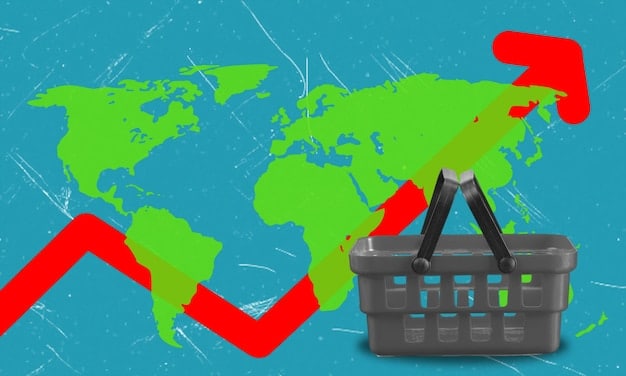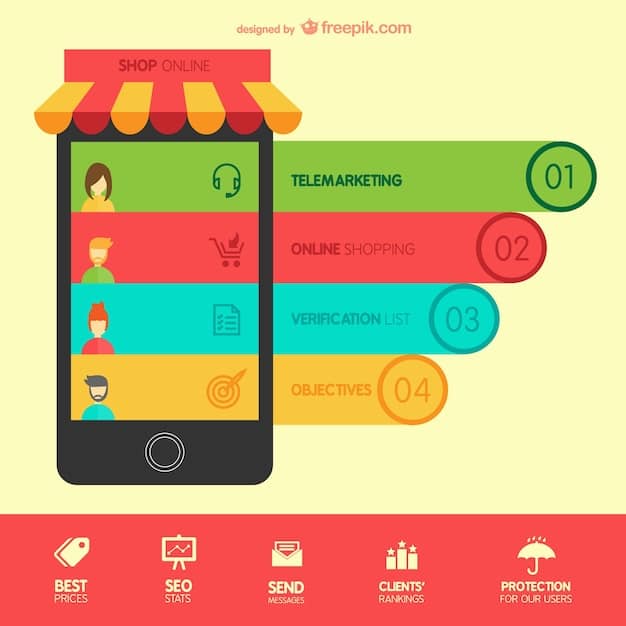E-commerce Subscriptions in the US: Long-Term Growth or a Fleeting Trend?

E-commerce subscription services have surged in popularity in the US market, offering recurring deliveries of products; however, the question remains whether this business model is truly sustainable for long-term growth or just a passing trend.
The e-commerce subscription services surge in the US has transformed how consumers shop, offering convenience and personalization. But is this model a sustainable path to long-term growth, or a trend destined to fade? Let’s delve into the dynamics shaping the future of e-commerce subscriptions.
Understanding the E-commerce Subscription Boom
The e-commerce landscape has seen a significant shift with the rise of subscription-based services. These services offer consumers the convenience of receiving products regularly without the need to repeatedly place orders. This model has gained traction across various industries, from beauty and fashion to food and household goods.
The Appeal to Consumers
One of the primary reasons for the popularity of e-commerce subscriptions is their ability to cater to individual preferences. By curating products based on customer profiles, these services deliver personalized experiences. Moreover, the element of surprise and discovery associated with receiving a curated box adds to the overall appeal.
Benefits for Businesses
For businesses, subscription models offer several advantages. They provide a consistent revenue stream, enhance customer loyalty, and facilitate better inventory management. Additionally, the recurring nature of subscriptions allows companies to gather valuable data on consumer behavior, enabling them to refine their offerings and marketing strategies.
- Predictable Revenue: Consistent income helps in financial planning.
- Customer Retention: Subscribers tend to stay loyal longer.
- Data Insights: Recurring interactions offer valuable customer data.
- Inventory Efficiency: Easier to manage stock with predictable demand.
In conclusion, the e-commerce subscription boom can be attributed to its dual benefits for consumers and businesses alike, fostering a market dynamic built on convenience, personalization, and recurring revenue.

The Different Types of Subscription Models
E-commerce subscription models are not one-size-fits-all; they come in various forms to cater to different needs and preferences. Understanding these different types is crucial for businesses looking to enter or optimize their subscription offerings.
Curation Subscription
This model delivers a selection of curated items, often around a specific theme or interest. Examples include beauty boxes, book clubs, and wine subscriptions. The value proposition lies in the expertise of the curators and the discovery of new products.
Replenishment Subscription
This model focuses on automating the purchase of essential items that consumers regularly use. Examples include razor blades, diapers, and coffee. The emphasis is on convenience and ensuring that customers never run out of these essentials.
Access Subscription
This model provides exclusive access to products or services in exchange for a recurring fee. Examples include streaming services, online courses, and exclusive content platforms. The value here is in the premium content or experiences offered.
- Curation: Discovery and expert selections.
- Replenishment: Convenience and automated delivery.
- Access: Exclusive content and premium features.
- Hybrid: Combining elements of multiple models.
In summation, the diversity in e-commerce subscription models allows businesses to tailor their offerings to specific market segments and consumer needs. Understanding the nuances of each model is essential for creating a successful subscription service.
Factors Influencing Sustainability
While the e-commerce subscription market has experienced rapid growth, its long-term sustainability depends on several critical factors. These factors range from economic conditions to consumer preferences and competitive pressures.
Economic Conditions
Economic downturns can significantly impact subscription services. During times of financial uncertainty, consumers may cut back on non-essential subscriptions to save money. Therefore, subscription businesses need to be resilient and offer value that justifies the recurring cost, even in tough economic climates.
Changing Consumer Preferences
Consumer tastes and preferences are constantly evolving. What is popular today may not be tomorrow. Subscription services must continuously innovate and adapt to stay relevant. This includes updating product selections, improving personalization, and offering new features.
Competitive Landscape
The e-commerce subscription market is becoming increasingly crowded. New players are constantly entering the space, increasing competition and putting pressure on existing businesses. To stand out, companies must differentiate themselves through superior products, exceptional customer service, and unique value propositions.

Ultimately, the sustainability of the e-commerce subscription model hinges on its ability to provide consistent value, adapt to changing consumer preferences, and navigate an increasingly competitive landscape. Businesses that can successfully address these factors will be best positioned for long-term success.
Challenges and Pitfalls
Despite the opportunities, e-commerce subscription services face several challenges that can hinder their sustainability. Understanding these potential pitfalls is crucial for businesses looking to thrive in this space.
Customer Churn
High customer churn rates are a significant concern for subscription businesses. Customers may cancel their subscriptions for various reasons, including dissatisfaction with the products, high costs, or simply losing interest. Reducing churn requires a focus on customer satisfaction and retention strategies.
Logistics and Fulfillment
Efficient logistics and fulfillment are essential for subscription services. Delays, damaged products, or incorrect orders can lead to customer dissatisfaction and cancellations. Businesses need to invest in robust supply chain management and fulfillment processes.
Marketing and Acquisition Costs
Acquiring new subscribers can be expensive. Marketing costs are rising, and competition for customers is fierce. Businesses need to develop cost-effective marketing strategies and focus on retaining existing customers to reduce acquisition costs.
- High Churn: Retain customers through value and engagement.
- Logistics: Streamline supply chains for reliability.
- Acquisition Costs: Optimize marketing for efficiency.
- Inventory Mismatch: Balance supply with subscriber demand.
In summary, challenges like churn, logistics, and high acquisition costs need careful management in the e-commerce subscription model. Overcoming these hurdles is crucial for achieving long-term sustainability.
Strategies for Long-Term Success
To ensure long-term success in the e-commerce subscription market, businesses need to adopt proactive strategies that address the challenges and capitalize on the opportunities. These strategies include focusing on personalization, customer engagement, and operational efficiency.
Personalization is Key
Personalization is crucial for retaining subscribers. Tailoring product selections, recommendations, and communications to individual preferences can significantly enhance customer satisfaction and loyalty. Utilizing data analytics to understand customer behavior is essential for effective personalization.
Enhancing Customer Engagement
Engaging with subscribers beyond the delivery of products can foster a stronger sense of community and loyalty. This can include hosting online events, creating exclusive content, and soliciting feedback on product selections. Engaged customers are more likely to remain subscribed long-term.
Streamlining Operations
Efficient operations are essential for managing costs and ensuring customer satisfaction. Streamlining supply chain management, improving fulfillment processes, and optimizing inventory management can help businesses deliver value and maintain profitability. Automation and technology can play a significant role in improving operational efficiency.
Ultimately, the key to long-term success in the e-commerce subscription market lies in continuously improving the customer experience, enhancing engagement, and optimizing operations.
The Future of E-commerce Subscriptions
The future of e-commerce subscriptions looks promising, with several trends shaping the market. These trends include the integration of artificial intelligence, the rise of niche subscriptions, and the increasing focus on sustainability.
The Role of AI
Artificial intelligence (AI) is set to play a significant role in the future of e-commerce subscriptions. AI can be used to personalize product recommendations, predict customer churn, and optimize marketing campaigns. By leveraging AI, businesses can create more engaging and efficient subscription services.
Niche Subscriptions on the Rise
Niche subscriptions catering to specific interests and hobbies are gaining popularity. These subscriptions offer curated products tailored to unique passions, creating a strong sense of community among subscribers. Examples include subscriptions for rare teas, vintage vinyl records, and artisanal crafts.
Sustainability as a Differentiator
Consumers are increasingly concerned about the environmental impact of their purchases. Subscription services that prioritize sustainability, such as using eco-friendly packaging and sourcing ethical products, can attract and retain environmentally conscious customers. Sustainability is becoming a key differentiator in the e-commerce subscription market.
In conclusion, the future of e-commerce subscriptions will be shaped by AI, niche offerings, and a focus on sustainability. Businesses that embrace these trends will be well-positioned to thrive in the evolving market.
| Key Point | Brief Description |
|---|---|
| 📦 Subscription Models | Curation, replenishment, and access subscriptions cater to varied needs. |
| 📈 Sustainability Factors | Economic conditions, consumer preferences, and competition impact long-term viability. |
| 🔑 Keys to Success | Personalization, enhanced engagement, and operational efficiency are critical. |
| 🤖 Future Trends | AI integration, niche subscriptions, and sustainability are driving future growth. |
Frequently Asked Questions
The main types include curation (offering curated selections), replenishment (automating essential purchases), and access (providing exclusive content or services for a recurring fee).
Sustainability depends on economic conditions, changing consumer preferences, and competitive dynamics. Maintaining value and adapting to market trends are crucial for success.
Strategies include personalizing product selections, enhancing customer engagement through exclusive content, and ensuring consistent product quality and on-time delivery.
AI can personalize recommendations, predict churn, and optimize marketing campaigns, enhancing customer satisfaction and operational efficiency in the subscription model.
Consumers are increasingly concerned about environmental impact, favoring businesses that prioritize eco-friendly practices, making sustainability a key differentiator for subscription services.
Conclusion
In conclusion, the surge in e-commerce subscription services in the US presents both opportunities and challenges. While the model offers convenience and recurring revenue streams, its long-term sustainability hinges on factors such as economic conditions, evolving consumer preferences, and the ability to adapt to a competitive landscape. By focusing on personalization, customer engagement, and operational efficiency, businesses can harness the power of subscriptions for sustained growth.





